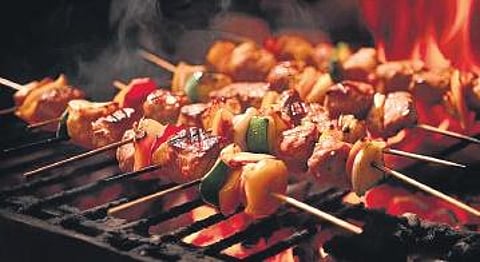

HYDERABAD: Cooking food over fire is a practice that dates back thousands of years and has played a crucial role in the development of human civilisation. The exact origins of cooking on fire are unknown, but it is believed to have emerged around 1.9 million years ago when hominids discovered the benefits of controlling fire. Fire provided warmth, protection, and a means to cook food.
History of cooking over an open fire
Initially, early humans roasted meat and vegetables directly over open flames. Cooking food has numerous advantages, such as making it palatable, easier to chew, and safer to consume by killing harmful bacteria and parasites.
As human societies progressed, cooking techniques became more sophisticated. Cooking vessels made of clay or animal skins were introduced, allowing for the boiling of food. This expanded the variety of dishes that could be prepared.
With the development of agriculture and settled communities, culinary practices evolved. Humans started to cultivate crops, domesticate animals, and develop techniques for baking bread, brewing beer, and fermenting food. Cooking techniques diversified, leading to the creation of stews, soups and more complex dishes.
Over time, humans invented various cooking tools to improve their culinary practices. These included utensils like knives, skewers, pots, pans, grills and spits. Such tools made it easier to handle food over an open fire and expanded the range of cooking methods.
According to Indu Bhargavi K, Nutrition lecturer, at St. Francis College for Women, “The traditional method of cooking over fire has been a part of every generation. However, nowadays, barbeque has become the most popular cuisine, despite its delicious taste, it poses various health risks. Cooking meat over an open fire with coal can increase the presence of carcinogens, which may lead to cancer. In the past, coal was in its natural state, and the meat used was fresh.
However, in the present times, coal is often adulterated, and meat may not be as fresh as it used to be due to storage and refrigeration practices.” Akshay Kumar, Executive Chef, Taj Vivanta, Hyderabad, asserts that traditional cooking techniques such as spit roasting or grilling using skewers or the age-old use of a tandoor, which involve cooking over an open flame, have been passed down through generations and continue to be an integral part of culinary practices. He believes that these age-old methods will persist and remain relevant.
Introduction to stoves
The advent of stoves revolutionised cooking. In ancient civilisations, clay stoves and ovens fueled by wood or charcoal became prevalent. These stoves allowed for more controlled cooking temperatures and facilitated the preparation of elaborate meals.
The Industrial Revolution in the 18th century brought significant advancements in cooking technology. The invention of the cast-iron stove, followed by gas stoves and electric stoves, made cooking efficient, convenient, and accessible to a wider population. Today, we have a wide range of cooking appliances and methods, from gas and electric stoves to microwaves, ovens, grills, and induction cooktops.
Not so fiery deal
While cooking on fire has been a fundamental cooking method throughout history, it also has some disadvantages. Here are a few:
Cooking over an open fire can be challenging when it comes to controlling and adjusting the cooking temperature. Fire tends to produce high, direct heat, which can lead to uneven cooking, especially when compared to modern cooking appliances with temperature control features.
Cooking on fire produces smoke, which can cause air pollution both indoors and outdoors. In poorly ventilated spaces, smoke can accumulate, leading to respiratory issues and discomfort. Additionally, the burning of wood or other solid fuels contributes to air pollution and can have negative environmental impacts.
Cooking over an open fire poses certain safety risks and can be time-consuming. There is a higher risk of accidental burns or injuries due to the open flame and hot embers. Care must be taken to ensure the fire is properly extinguished after cooking. Building and maintaining a fire, gathering firewood or fuel, and waiting for the fire to reach the desired temperature, all add to the overall cooking time and preparation process.
Despite these disadvantages, many people still enjoy cooking on fire for its unique flavours, nostalgic appeal, and connection to nature. It continues to be a popular method for outdoor cooking, camping, and traditional cooking practices in various cultures around the world.